|
● Football
● How
the Game Is Played
● Baseball
● How
the Game Is Played
● Basketball
● How
the Game Is Played
● Other
Sports Activities
Baseball
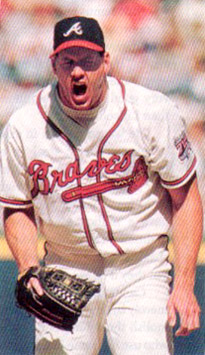 |
|
A Baseball Player
|
 Baseball
may still be the great American game, even though many other countries
are deeply involved with the game. It is very popular, for instance,
in Japan, in Cuba, and in the
Dominican Republic. In America, many children (not
only boys these days) still play informal, "sandlot"
baseball in their neighborhoods. Small towns and cities still maintain
organized Little League or (for older
children) Babe Ruth baseball teams. In many cities, young
adults organize into informal "softball" leagues, and
universities still maintain varsity baseball teams. Finally, professional
baseball is still "big business". Baseball
may still be the great American game, even though many other countries
are deeply involved with the game. It is very popular, for instance,
in Japan, in Cuba, and in the
Dominican Republic. In America, many children (not
only boys these days) still play informal, "sandlot"
baseball in their neighborhoods. Small towns and cities still maintain
organized Little League or (for older
children) Babe Ruth baseball teams. In many cities, young
adults organize into informal "softball" leagues, and
universities still maintain varsity baseball teams. Finally, professional
baseball is still "big business".
 |
|
The Anaheim Stadium
|
 Earlier,
before television and air travel, professional baseball was confined
to a few cities mostly, but not exclusively, on the East coast .
Baseball parks were located near the urban centers and were small
compared to football fields. Even today, the largest baseball stadium
is the home field of the California Angels, Anaheim Stadium, which
holds almost 65 000 spectators, while older Fenway Park, the Earlier,
before television and air travel, professional baseball was confined
to a few cities mostly, but not exclusively, on the East coast .
Baseball parks were located near the urban centers and were small
compared to football fields. Even today, the largest baseball stadium
is the home field of the California Angels, Anaheim Stadium, which
holds almost 65 000 spectators, while older Fenway Park, the
 |
|
Fenway Park
|
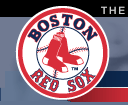 |
|
Boston Red Sox Logo
|
home of the Boston
Red Sox, holds only 34 000 fans. The activity involved
in baseball is not as intense as that in other sports, hence games
can be played one day after another, and even two games on one day—a doubleheader.
Baseball used to be played only in the daytime, but after World
War II, parks began to install massive lighting systems, and night
baseball increased in popularity.
 The
less intense activity on the playing field also means that spectators
can watch the game in a more relaxed and lazy way, an ideal way
to fritter away a hot summer afternoon. Beer and soft drinks
are available in addition to such snacks as peanuts, popcorn and
Cracker jacks (popped corn covered with a crisp coating of
dried molasses). Fans will undoubtedly eat at least one of
the American sausages called a Frankfurter (Hot Dog, Frank, Red
Hot), with pickles, onions, relish and slathered with mustard
or ketchup. The
less intense activity on the playing field also means that spectators
can watch the game in a more relaxed and lazy way, an ideal way
to fritter away a hot summer afternoon. Beer and soft drinks
are available in addition to such snacks as peanuts, popcorn and
Cracker jacks (popped corn covered with a crisp coating of
dried molasses). Fans will undoubtedly eat at least one of
the American sausages called a Frankfurter (Hot Dog, Frank, Red
Hot), with pickles, onions, relish and slathered with mustard
or ketchup.
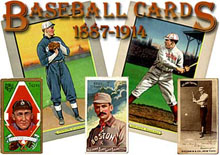 |
| Early Baseball
Cards |
 Before
World War II, there were two major leagues, or groupings, of baseball
teams, The older National League and the American League. A third
professional grouping, located in the South and attended almost
entirely by African Americans, was the Negro League, a reflection
of the segregation
policies prevalent
then even in Northern cities. Players usually were identified over
long periods of time with one team. As
a result there was much fan loyalty not only to the team but also
to individual players. Fans could quote the performance records
of their favorite players, readjusting the figures every day after
reviewing the newspaper accounts of the previous day's game.
Children (at this time, boys) would collect Baseball Cards, 2 x
3 inch cards having a posed picture of a player on one side, and
information about him on the other. These cards were only available
in packages of chewing
gum marketed particularly for children. (Later these
cards were sold separately from the chewing gum. Early
cards are collectors items, and command high prices in the
souvenir
business. Before
World War II, there were two major leagues, or groupings, of baseball
teams, The older National League and the American League. A third
professional grouping, located in the South and attended almost
entirely by African Americans, was the Negro League, a reflection
of the segregation
policies prevalent
then even in Northern cities. Players usually were identified over
long periods of time with one team. As
a result there was much fan loyalty not only to the team but also
to individual players. Fans could quote the performance records
of their favorite players, readjusting the figures every day after
reviewing the newspaper accounts of the previous day's game.
Children (at this time, boys) would collect Baseball Cards, 2 x
3 inch cards having a posed picture of a player on one side, and
information about him on the other. These cards were only available
in packages of chewing
gum marketed particularly for children. (Later these
cards were sold separately from the chewing gum. Early
cards are collectors items, and command high prices in the
souvenir
business.
 This
was the period of hero worship, the era of the Lone Eagle, Lindbergh),
who conquered the Atlantic Ocean. Perhaps,
as industrialization spread through America, people felt they were
losing control of their lives, that they were becoming buried and
lost in a mass, faceless society. To return to some mythical
past,
where woodsmen and cowboys supposedly conquered nature and wild
savages
through
personal effort and courage, was one way to preserve the notion
of individual triumph. And in the present, sports heroes could also
serve to remind Americans that talented individuals can succeed
through hard work. This
was the period of hero worship, the era of the Lone Eagle, Lindbergh),
who conquered the Atlantic Ocean. Perhaps,
as industrialization spread through America, people felt they were
losing control of their lives, that they were becoming buried and
lost in a mass, faceless society. To return to some mythical
past,
where woodsmen and cowboys supposedly conquered nature and wild
savages
through
personal effort and courage, was one way to preserve the notion
of individual triumph. And in the present, sports heroes could also
serve to remind Americans that talented individuals can succeed
through hard work.
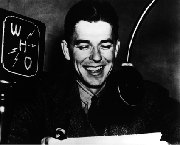 |
|
Reagan as Sports
Announcer
|
 The
radio announcers broadcasting descriptions of the games, and newspaper
columnists
(who frequently were masters of the short colloquial
essay or story) writing about the games, exaggerated the exploits
on the field and idealized the personal lives of players, thus actually
creating many of the colorful heroes of this time. Sportswriter
Westbrook Pegler
became later in life a conservative political columnist, and sports
radio announcer Ronald
Reagan also became involved in politics later in his life. The
radio announcers broadcasting descriptions of the games, and newspaper
columnists
(who frequently were masters of the short colloquial
essay or story) writing about the games, exaggerated the exploits
on the field and idealized the personal lives of players, thus actually
creating many of the colorful heroes of this time. Sportswriter
Westbrook Pegler
became later in life a conservative political columnist, and sports
radio announcer Ronald
Reagan also became involved in politics later in his life.
 |
|
Jackie Robinson
|
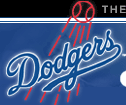 |
| Dodger
Logo |
 After
World War II, great changes in the game took place. First, there was
the demolition
of the color barrier, starting slowly with the hiring of the superb
athlete, African-American Jackie
Robinson, by Brooklyn
Dodgers manager
Branch Rickey. At first Robinson was booed
whenever he appeared on the field. But several of his respected teammates
showed their solidarity with him. Then a few other teams hired African-Americans
who had demonstrated their abilities with the Negro Baseball League.
Still there were problems with segregated transportation facilities
and with segregated dining and housing regulations in some cities.
Gradually all teams have become integrated. The courage and determination
of Jackie Robinson (and Branch Rickey) will never be forgotten. After
World War II, great changes in the game took place. First, there was
the demolition
of the color barrier, starting slowly with the hiring of the superb
athlete, African-American Jackie
Robinson, by Brooklyn
Dodgers manager
Branch Rickey. At first Robinson was booed
whenever he appeared on the field. But several of his respected teammates
showed their solidarity with him. Then a few other teams hired African-Americans
who had demonstrated their abilities with the Negro Baseball League.
Still there were problems with segregated transportation facilities
and with segregated dining and housing regulations in some cities.
Gradually all teams have become integrated. The courage and determination
of Jackie Robinson (and Branch Rickey) will never be forgotten.
 Improved
transportation led to the wider distribution of teams; cities that
formerly had two teams lost one to cities that had no local baseball
team. Television too brought in increasing revenues,
and players began to negotiate for higher salaries. Players themselves
began to be traded to other teams almost as easily as children traded
the players' cards. Even then there were not enough baseball teams
to locate in every city that wanted one, so a modest number of new
teams were created. This necessitated a longer playing season, which
in turn led to the desirability of covered stadiums, especially in
the far northern part of the country. Improved
transportation led to the wider distribution of teams; cities that
formerly had two teams lost one to cities that had no local baseball
team. Television too brought in increasing revenues,
and players began to negotiate for higher salaries. Players themselves
began to be traded to other teams almost as easily as children traded
the players' cards. Even then there were not enough baseball teams
to locate in every city that wanted one, so a modest number of new
teams were created. This necessitated a longer playing season, which
in turn led to the desirability of covered stadiums, especially in
the far northern part of the country.
 The
baseball season now begins with Spring Training in February at places
such as Florida and Arizona, where the weather is mild at that time
of year. The regular season begins at the beginning of April, and
ends in October. The World Series between the leading teams in their
respective leagues takes place in the latter part of October, when
it is frequently uncomfortably cold for the players. This best four
out of seven games determines the annual World Series Champions, and
marks the end of the baseball season. The World Series is an occasion
for neighbors and co-workers to engage in some minor wagering
on the outcome of the games. Betting on baseball games has always
been present, even leading once to a scandal
of players affecting the outcome of a game on direction by big money
gamblers
(The Black Sox' scandal
of 1919). Yet until recently the amount of money wagered had
been relatively small. Now, gambling on sporting events such as baseball
(and football and basketball, too) represents a sizable amount of
money, as more and more Americans wager larger and larger amounts
on these events. The
baseball season now begins with Spring Training in February at places
such as Florida and Arizona, where the weather is mild at that time
of year. The regular season begins at the beginning of April, and
ends in October. The World Series between the leading teams in their
respective leagues takes place in the latter part of October, when
it is frequently uncomfortably cold for the players. This best four
out of seven games determines the annual World Series Champions, and
marks the end of the baseball season. The World Series is an occasion
for neighbors and co-workers to engage in some minor wagering
on the outcome of the games. Betting on baseball games has always
been present, even leading once to a scandal
of players affecting the outcome of a game on direction by big money
gamblers
(The Black Sox' scandal
of 1919). Yet until recently the amount of money wagered had
been relatively small. Now, gambling on sporting events such as baseball
(and football and basketball, too) represents a sizable amount of
money, as more and more Americans wager larger and larger amounts
on these events.
 Major
league baseball stadiums have gotten larger and larger in recent times.
The price of tickets has also risen considerably. Thus, more and more
Americans are turning to minor league baseball played in some of the
smaller cities around America. The minor league teams are supported
by the major league owners as a place where new players can gain experience
and improve their skills. Frequently a young player is called
up to play in the major league, and sometimes a player
in the majors who is not performing well may be sent
down to the minors. Major
league baseball stadiums have gotten larger and larger in recent times.
The price of tickets has also risen considerably. Thus, more and more
Americans are turning to minor league baseball played in some of the
smaller cities around America. The minor league teams are supported
by the major league owners as a place where new players can gain experience
and improve their skills. Frequently a young player is called
up to play in the major league, and sometimes a player
in the majors who is not performing well may be sent
down to the minors.
Previous Page Next
Page
|

